Gonville and Caius College, Cambridge: Difference between revisions
Created page with "{{Infobox college |name=Gonville and Caius College |university=Cambridge |picture=Cambridge_Gonville_and_Caius_College.jpg |picture caption=Gonville & Caius College from King'..." |
No edit summary |
||
| Line 10: | Line 10: | ||
|headtext=black | |headtext=black | ||
|arms=Gonville & Caius College Crest.svg | |arms=Gonville & Caius College Crest.svg | ||
|scarf={{scarf|black|1|#88bbcc|1|black | |scarf={{scarf|black|1|#88bbcc|1|black|1|#88bbcc|1}} | ||
|founders=Edmund Gonville (1348)<br />John Caius (1557) | |founders=Edmund Gonville (1348)<br />John Caius (1557) | ||
|established=1348, refounded 1557 | |established=1348, refounded 1557 | ||
Latest revision as of 21:13, 1 April 2024
| Gonville and Caius College
| |||||||||
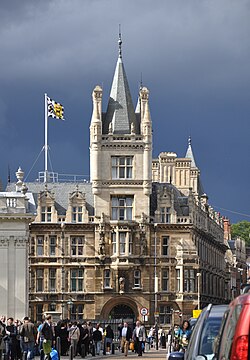 Gonville & Caius College from King's Parade | |||||||||
|---|---|---|---|---|---|---|---|---|---|
 | |||||||||
| Master: | Pippa Rogerson | ||||||||
| Website: | cai.cam.ac.uk | ||||||||
| |||||||||
| Location | |||||||||
| Grid reference: | TL44825852 | ||||||||
| Location: | 52°12’21"N, -0°7’4"E | ||||||||
Gonville and Caius College, often referred to simply as Caius is a constituent college of the University of Cambridge, in Cambridge, Cambridgeshire. The name 'Caius' is pronounced 'Keys'.
Founded in 1348 by Edmund Gonville, this is the fourth-oldest of the University of Cambridge's 31 colleges and one of the wealthiest. In 1557, it was refounded by alumnus John Caius, (who was in fact 'John Kays', before he Latinised his name to 'Caius' in the academic fashion).
The college has been attended by many students who have gone on to significant accomplishment, including fifteen Nobel Prize winners, the second highest of any Oxbridge college.[1][2] Several streets in the city, including Harvey Road, Glisson Road, and Gresham Road, are named after Gonville and Caius alumni.[3] The college and its masters have been influential in the development of the university, including in the founding of other colleges, including Trinity Hall and Darwin College and providing land on Sidgwick Site on which the Faculty of Law was built.
History
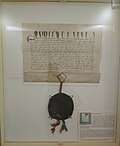


The college was founded in 1348 as Gonville Hall by Edmund Gonville, a clergyman who hailed from a gentry family of French origin. Gonville held various positions in the English Church, serving as Rector of three parishes, Thelnetham (1320–26), Rushford, Norfolk (1326–1342), and Terrington St Clement (1343–1351). Such occupations afforded him sufficient wealth that he was able to lend money to Edward III, an act that saw him appointed a King's Clerk.[4]
With the support of Sir Walter Manny, Gonville petitioned the king for permission to found a college at Cambridge consisting of 20 scholars. In January 1348, Edward III granted this request and issued Letters patent. Its 1348 founding makes Gonville and Caius the fourth-oldest surviving college at Cambridge.
Gonville died three years later, in 1351, and left behind an institution that had begun to struggle financially. William Bateman, Bishop of Norwich, intervened and moved the college to its current location off Trinity Street in central Cambridge. He also leased himself land close to the River Cam to set up his own college, Trinity Hall. Gonville Hall was renamed The Hall of the Annunciation of the Blessed Virgin Mary and Bateman appointed his former chaplain John Colton, who was later made Archbishop of Armagh, as the college's master.
By the sixteenth century, the college had fallen into disrepair. In 1557, it was refounded by Royal Charter as Gonville and Caius College by alumnus John Caius.[5] Caius had read divinity at the college between 1529 and 1533 and later travelled to Renaissance Italy, where he studied medicine at the University of Padua under Montanus and Vesalius. Following his return to England, Caius had become a renowned physician and served many terms as president of the Royal College of Physicians. At the time of the college's re-founding, he had worked as physician to two English monarchs, Edward VI and Mary I, and later served in the same capacity for Elizabeth I.[6]
Following the death of Thomas Bacon, Caius was appointed master of the college on 24 January 1559, a position he held until shortly before his own death in 1573. He provided the college with significant funds and greatly expanded the college's buildings. Caius accepted no payment for his services but insisted on several rules, including that the college admit no scholar who "is deformed, dumb, blind, lame, maimed, mutilated, a Welshman, or suffering from any grave or contagious illness, or an invalid, that is sick in a serious measure". (It has been suggested that Wallicum in the charter was not intended to exclude Welshmen but was a scribal error for Gallicum, indicating one suffering from the 'morbus Gallicus'; syphyllis.)[7] Caius also built a three-sided court, Caius Court, "lest the air from being confined within a narrow space should become foul". Caius was responsible for developing the college's strong global reputation in medicine, which continues to this day.
By 1630, the college had expanded greatly with roughly 25 fellows and 150 students. But the number of fellows and students fell in the following century, returning to the 1630 level only in the early nineteenth century. Since then, Gonville and Caius has grown considerably, and it has now one of the University of Cambridge's largest undergraduate populations. In 1979, the college first admitted women as fellows and students.
Gonville and Caius is one of the wealthiest of all Cambridge colleges with an endowment of £221 million in 2018.[8]
Buildings and grounds
Old Courts
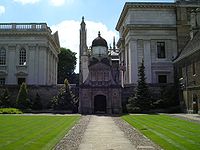
The first buildings erected on the college's current site date from 1353 when Bateman built Gonville Court. The college chapel was added in 1393 with the Old Hall (used until recently as a library); Master's Lodge followed in the next half century. Most of the stone used to build the college came from Ramsey Abbey near Ramsey in Huntingdonshire. Gonville and Caius has the oldest purpose-built college chapel in continuous use in either Oxford or Cambridge. The chapel is situated centrally within the college, reflecting the college's religious foundation.
On the re-foundation by Caius, the college was expanded and updated. In 1565, the building of Caius Court began, and Caius planted an avenue of trees in what is now known as Tree Court.
Caius was also responsible for building the college's three gates, symbolising the path of academic life:
- the Gate of Humility, near the Porters' Lodge in the centre of the campus - passed though by students on matriculation;
- the Gate of Virtue, between Tree Court and Caius Court - passed frequently through the during their time as students;
- the Gate of Honour to the neighbouring Senate House, - passed through by students on the way to receive their degrees.
The buildings expert James D. Wenn has identified number of meanings in the gate of honour associated with the practice of medicine in classical antiquity, Plato and the geometry of the rhombic dodecahedron.[9][10][11]

The Gate of Honour is only used for special occasions, including graduation (Students of Gonville and Caius commonly refer to a fourth gate in the college, between Tree Court and Gonville Court, which also gives access to some lavatories, as the Gate of Necessity). The architectural expert James D. Wenn has identified that philosophical and meanings coded into coded into the Gate of Honour.[11][9][10]
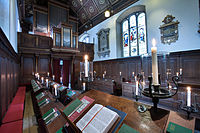
The buildings of Gonville Court were given classical facades in the 1750s. The Old Library and Hall were designed by Anthony Salvin in 1854. On the wall of the Hall hangs a college flag, which in 1912 was flown at the South Pole by Cambridge's Edward Wilson during the Terra Nova Expedition of 1910–1913. Gonville Court, though remodelled in the 18th and 19th centuries, is the oldest part of the college. New lecture rooms were designed by Alfred Waterhouse and completed by Rattee and Kett in 1884.[12]
Libraries
Caius has one of the largest libraries in Oxbridge, housed in the Cockerell Building. Caius acquired the lease on the building, which previously housed the Seeley History Library and the Squire Law Library, in the 1990s. The college library was relocated there from Gonville Court in the summer of 1996, following an extensive renovation.
Other courts and college accommodations
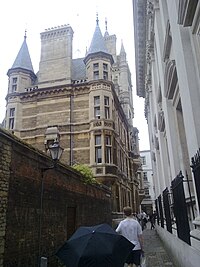
Across Trinity Street on land surrounding St Michael's Church. St Michael's Court was completed in the 1930s; on the south side of St Michael's Court is new campus building that overlooks Market Place. The college also owns several houses around Cambridge, on Mortimer Road and Gresham Road, where some second year undergraduates live, and on Harvey Road and St Paul's Road, which are occupied by graduate students.
Grounds
The Fellows' garden lies just beyond Harvey Court, on Sidgwick Avenue. The extensive sports fields are located on Barton Road, a short walk from Harvey Court.
Pictures
| ("Wikimedia Commons" has material about Gonville and Caius College, Cambridge) |
-
The Gate of Honour
-
Dining Hall
-
Fellows' Dining Room
-
Stained-glass window in dining hall, commemorating Charles Scott Sherrington
-
Stained-glass window in dining hall, commemorating John Venn, who invented the concept of the Venn diagram
-
Stained-glass window in dining hall, commemorating Francis Crick, who co-discovered the molecular structure of DNA
-
View from Great St Mary's Church
-
The library
-
The old boathouse (demolished in 2015)
-
College crest
Outside links
References
- ↑ "College Research – Caius College Cambridge". Gonville & Caius College. 15 October 2012. http://www.cai.cam.ac.uk/research.
- ↑ "Nobel Prize Winners – Research – University of Cambridge". University of Cambridge. http://www.cam.ac.uk/research/about/awards-announcements-and-prizes/nobel-prize-winners/.
- ↑ Brooke, Christopher A History of Gonville & Caius College (Rochester, 1985), p. 225, n10.
- ↑ {{#invoke:citation/CS1|citation |CitationClass=encyclopaedia }} (subscription or UK public library membership required)
- ↑ "History – Gonville & Caius". Gonville & Caius College. 15 October 2012. http://www.cai.cam.ac.uk/history.
- ↑
 {{#invoke:citation/CS1|citation
|CitationClass=encyclopaedia
}}
{{#invoke:citation/CS1|citation
|CitationClass=encyclopaedia
}}
- ↑ Brooke, Christopher. A History of Gonville & Caius College. p. 144. https://www.cai.cam.ac.uk/sites/default/files/AHistoryofGonvilleandCaiusCollege.epub.
- ↑ "Finance and Annual Reports". May 2017. https://www.cai.cam.ac.uk/discover/strategy-and-policies/finance-and-annual-reports.
- ↑ 9.0 9.1 Thegns of Mercia
- ↑ 10.0 10.1 Incubation is the Prescription: Renaissance Medicine in Text and Architecture - YouTube
- ↑ 11.0 11.1 Garnet as Emblem of Goodness: Philosophical architecture from Henry III to George III - YouTube
- ↑ Venn, John (1901). Biographical History of Gonville and Caius College. Cambridge University Press. p. 148. https://books.google.com/books?id=0m08AAAAIAAJ&q=%22Rattee+and+Kett%22+logo&pg=PA148.
- Brooke, C.: 'A history of Gonville and Caius College' (Boydell, 1985; corrected reprint, 1996) ISBN 0-85115-423-9
| Colleges of the University of Cambridge | |
|---|---|
|
Christ’s • Churchill • Clare • Clare Hall • Corpus Christi • Darwin • Downing • Emmanuel • Fitzwilliam • Girton • Gonville and Caius • Homerton • Hughes Hall • Jesus • King’s • Lucy Cavendish • Magdalene • Murray Edwards • Newnham • Pembroke • Peterhouse • Queens’ • Robinson • St Catharine’s • St Edmund’s • St John’s • Selwyn • Sidney Sussex • Trinity • Trinity Hall • Wolfson |
 |










